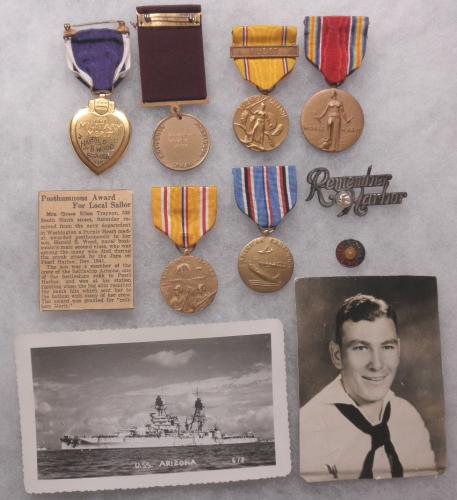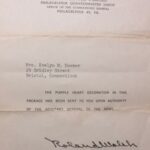Raymond Leonard Decker was born December 23, 1920 and subsequently enlisted in the army on May 19, 1943. He was with the 173rd Field Artillery as part of the Fifth Army that went through North Africa anf then to Italy. He was killed by shrapnel wounds to the chest and abdomen near Scanello, Italy. Decker was one of 4 killed on December 28, which indicates he was probably on a 155 howitzer gun crew that was struck by enemy artillery. According to the history he was one of a very few casualties in the Battalion. He was initially buried in the Mt. Beni US Military Cemetery, Pietramala, Italy, Plot H, Row 23, Grave 1130. At the request of his wife, he was reinterred in Arlington January 27, 1949 in Section 12, Grave Number 5333. His wife's brother, Cpl. Dennis A. Rich was also KIA.
Private Decker's group includes his officially engraved posthumous slot brooch Purple Heart, edge number 473527, and the presentation box. Accompanying the group is a 60 page IDPF file copy.
The official history of the 173rd was written by Capt. Benton Burns in 1945. Following is a synopsis of the history taken from that book for the period of Fall and Winter 1944-1945.
"With Florence taken, once again the Germans fell back hurriedly to the Gothic Line. The two armies raced up Highway 65, in Capt. Burns’ words “like a giant stone crusher swallowing towns whole and leaving piles of rubble in their wake.” The 173rd FA maintained heavy fire from successive positions in Le Croci, Camoggiano, Gagliano, and finally Gragano. Moving through Futa Pass in the Gothic Line, where the enemy had mounted a vigorous rear-guard action, the battalion went on to Traversa. While there the autumn rains and hated Italian mud returned. With difficulty the battalion went into position off Highway 6529 into a valley near Sambuco, which became a massive artillery park that included the 85th Division’s artillery as well as other units, 86 guns in all. The site became known in army slang as Black Rock for a notable landscape feature. On October 7, orders were received to move, but because of knee-deep mud and the steep terrain the actual movement was nightmarish. Bulldozers and tractors proved necessary to pull the battalions trucks and guns out of the valley. Only on October 15 was the battalion finally reunited at Qunizano, along Highway 65.
At Quinizano the mud, coupled with the bad condition of the shelled highway, made immediate passage impossible. Indeed the unit needed local oxen and wagons to get food and supplies to the men. Literally stuck in the mud, the battalion came to a stop. Its commanders rotated men through the winter to the mammoth rest center at Montecatini, while those left at the front continued firing on the Germans, endured counter-battery fire and air attacks, and with difficulty given the conditions once again retubed the guns. Snow began to fall in December as the weather turned cold. One man died and nine others were wounded on November 10 when Battery A’s No. 1 gun exploded. Two more died from enemy fire on December 10, and another four casualties fell on December 28. An additional two men were wounded on January 4, 1945. On January 12, with snow on the ground, the 173rd FA began shifting to a new position several miles in the rear, in a valley off Highway 65 near Firenzuola, in response to a German drive down the coast. After stringing wire the men pained the guns white in order to make them less obvious to enemy aircraft. Food and ammunition sometimes became scarce due to the difficulty of supplying the position. Yet throughout the winter, the three batteries maintained their fire against the enemy, sometimes with an 8” howitzer temporarily assigned to the battalion."
Spring 2022 sold to a collector.










